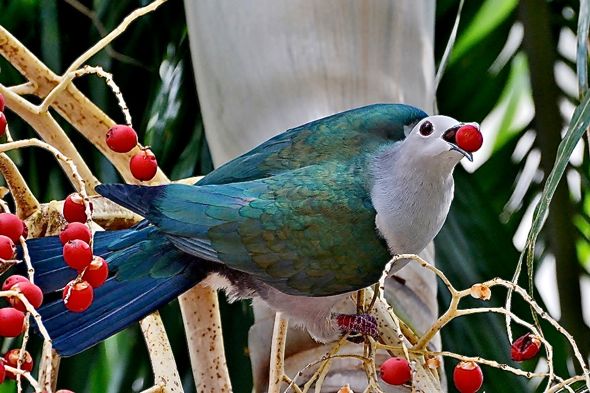“Quite a number of species were nesting towards end of April 2014. The Coppersmith Barbet (Megalaima haemacephala), Collared Kingfisher (Actenoides concretus), Pied Fantail (Rhipidura javanica), Common Iora (Aegithina tiphia), and Sooty-headed Bulbul (Pycnonotus aurigaster) were some of the species busy with nesting activities. I was pleasantly surprised and delighted to find a nesting of the Green Imperial-pigeon (Ducula aenea), supposedly a rare non-breeding visitor in Singapore. Amazingly, the nest was discovered lodged in a tree that was in an industrial estate in the eastern part of Singapore.
“First, a photo showing an adult that was about to swallow a ripened fruit of the MacArthur Palm (Ptychosperma macarthurii). Note the appearance of the green metallic sheen on the pigeon’s back, which will only appear under correct lighting conditions (above).
“Next, a picture showing one of the parents with the nest in the background (above). The nest was already completed when first discovered in end March 2014. It was built with sticks fixed onto the forking branches at the main trunk. The nest was located smack in the middle of a tree. Shielded by foliage, it stayed hidden from prying eyes.
“After a few fruitless trip, a single chick was finally spotted on 26 April. An adult, which was tending to the chick, was observed leaving the nest to defecate away from the nest in an adjacent tree (above, below).
“Both parents were observed keeping a watchful eye on their offspring. Sentry duties may be performed on adjacent trees a little distance away from the nest (below) where the adults may also preen themselves (bottom).”
“By May 2014, the chick must have fledged as both chick and parents were no longer found in the area.”
Kwong Wai Chong
Singapore
18th May 2014



![Green Imperial Pigeon [KwongWaiChong] - 2](https://besgroup.org/wp-content/uploads/Green-Imperial-Pigeon-KwongWaiChong-2.jpg)
![Green Imperial Pigeon [KwongWaiChong] - 3](https://besgroup.org/wp-content/uploads/Green-Imperial-Pigeon-KwongWaiChong-3.jpg)
![Green Imperial Pigeon [KwongWaiChong] - 4](https://besgroup.org/wp-content/uploads/Green-Imperial-Pigeon-KwongWaiChong-4.jpg)
![Green Imperial Pigeon [KwongWaiChong] - 5](https://besgroup.org/wp-content/uploads/Green-Imperial-Pigeon-KwongWaiChong-5.jpg)
![Green Imperial Pigeon [KwongWaiChong] - 6](https://besgroup.org/wp-content/uploads/Green-Imperial-Pigeon-KwongWaiChong-6.jpg)







4 Responses
Recently I have been seeing this bird around my condo here in the East near the airport. At first I thought it was an individual plundering the fruits of the palm trees around the condo. It will appear at the condo at about the same time every day. Today I saw a flight of 4 birds fly by just before the rain came in. Looks like they are here to stay.
How aboiut a short account for BESG?